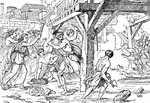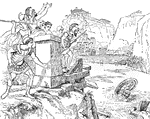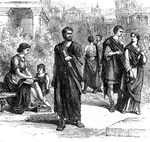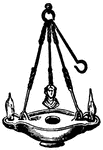
Sambuca
"A harp, was of oriental origin. The performances of sambucistriae were only known to the early Romans…

Signa Militaria
"Signa Militaria, military ensigns or standards. The most ancient standard employed by the Romans is…

Tela
"Tela, a loom. Although weaving was among the Greeks and Romans a distinct trade, carried on by a separate…
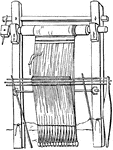
Tela
"Tela, a loom. Although weaving was among the Greeks and Romans a distinct trade, carried on by a separate…
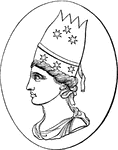
Tiara
"Tiara or Tiaras, a hat with a large high crown. This was the head-dress which characterized the north-western…

Tintinna'bulum
"Tintinna'bulum, a bell. Bells were of various forms among the Greeks and Romans, as among us. various…

Toga
"Toga, a gown, the name of the principal outer garment worn by the romans, seems to have been received…

Trochus
"Trochus, a hoop. The Greek boys used to exercise themselves, like ours, with trundling a hoop. It was…

Tunica
"Tunica, an under-garment. Roman. The Tunica of the Romans, like the Greek chiton, was a woollen under…

Turibulum
"Turibulum, a censer. The Greeks and Romans, when they sacrificed, commonly took a little frankincense…
Venatio
"Venatio, hunting was the name given among the Romans to an exhibition of wild beasts, which fought…
Venatio
"Venatio, hunting was the name given among the Romans to an exhibition of wild beasts, which fought…
Venatio
"Venatio, hunting was the name given among the Romans to an exhibition of wild beasts, which fought…
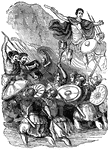
Caesar in England
"All histories of England commence with the invasion of Julius Caesar, the earliest event in that quarter…
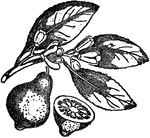
Lemon
The fruid of the tropical or subtropical tree citrus medica, of the orange family, and originally native…
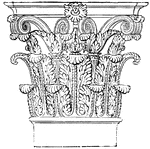
Roman-Corinthian Capital
"The favorite order was the richly-decorated Corinthian, the beauty of which the Romans strove to increase…
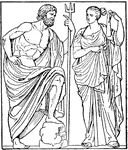
Poseidon
The Greek god of the sea, identified by the Romans with the Italian deity Neptune. A son of Kronos and…

Minerva
"The name of a Roman goddess, identified by the later Graecising Romans with the Greek Athene, whom…

Plough
"The Romans, an essentially practical nation, largely improved on the plough, adding to it the coulter…
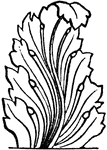
Acanthus
"The name given by the Greeks and Romans to the plants sometimes called Brancursine, of which it is…

Auricula
"A plant of the same genus with the Primrose, much cultivated in flower-gardens. The Auricula has long…

Roman Eagle
"Eagle, as a military standard, was adopted by the Romans, and even by nations preceding them in history.…
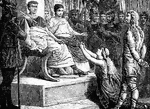
Caractacus And Claudius
Caractacus was a British Chief that had fought very bravely against the Romans. He was brought to Rome…
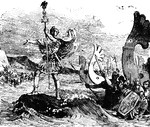
Julius Caesar
Julius Caesar heard that a little way off there was a country nobody knew anything about, except that…
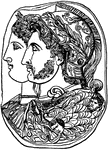
Cameo
Cameo, a term applied to gems of different colors sculptured in relief. The art of engraving on gems…

Ferret
"The Ferret was imported into Europe from Africa, and was well known to the Romans, being anciently…
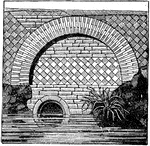
Reticulated Work
A species of masonry very common among the ancients, in which the stones are square and laid lozenge-wise,…
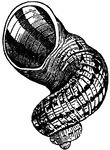
Helix Aspersa (Var. Scalaris)
"The snails are male and female in the same individual, or hermaphrodite. The Romans had many species…
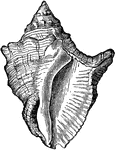
Purpura Consul.
"The Purpuras have a classical name and history, having furnished the Greeks and Romans with the brilliant…

Buccinum Senticosum (Linnaeus)
"The Purpuras have a classical name and history, having furnished the Greeks and Romans with the brilliant…

Aqueduct
This image depicts a market in front of The Aqueduct of Segovia, located in Segovia, Spain. It was built…

Morgan Dix
Morgan Dix (born November 1, 1827 in New York City; died April 29, 1908) was an American priest, "divine"…

Fennel
Fennel (Foeniculum vulgare) is a plant species in the genus Foeniculum (treated as the sole species…

Roman Ceiling Panels
A coffer in architecture, is a sunken panel in the shape of a square, rectangle, or octagon in a ceiling,…

Egg-and-Dart
Egg-and-dart is an ornamental device often carved in wood, stone, or plaster quarter-round ovolo mouldings,…

Ratisbon
Regensburg, also Ratisbon, Ratisbona, is a city in Bavaria, Germany, located at the confluence of the…

Ramparts of Ulm
Ramparts or limes, defensive walls or fortifications constructed for defense of ancient cities or settlement…

View of Lintz
A picturesque view of the Lintz (Linz) city center. Lintz was founded by the Romans, who called it "Lentia."…
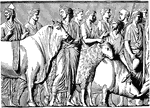
Suovetaurilia
The suovetaurilia was a sacred Roman sacrifice of a pig, a ram, and a bull to Mars, the god of war to…
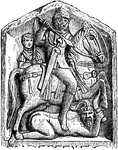
Sueve and Roman Rider
A Roman rider battling a Sueve. Suevi were Germanic people that posed a threat to the Romans.
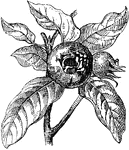
Leaves and Fruit of Common Medlar
The Common Medlar (Mespilus germanica) is a large shrub or small tree, and the name of the fruit of…

Walls of Carcassonne
The Walls of Carcassonne fortify the French town of Carcassonne in France. It was fortified on a hilltop…
!["After a successful summer campaign, [Caesar] made his way to the coast and cross over into Britain. He then withdrew into his winter-quarters in Gaul, but in the following year returned into the island, defeated the British Celts under their king Cassivellaunus, and reduced the country to a dependency, compelling the Britons to pay tribute and give hostages."](https://etc.usf.edu/clipart/78900/78943/78943_landing_01_mth.gif)
Landing of the Romans in Britain
"After a successful summer campaign, [Caesar] made his way to the coast and cross over into Britain.…

Tormenta Within a Fortified Camp
"The romans had no knowledge of gunpowder, siege cannon, or field guns; but the place of modern artillery…

An Athenian Trireme
An ancient ship used by Greeks and Romans. The ship has three rows of oars on each side, with a man…
